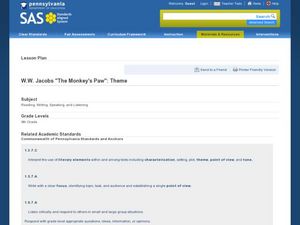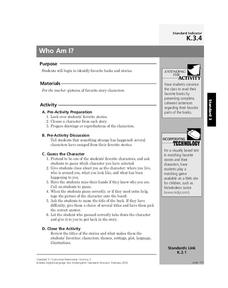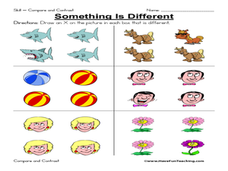Curated OER
Using Facebook with Literature
Young scholars use online social networking to learn about characters in literature. In this literature and technology lesson, students visit Facebook website and set up character profiles for a piece of literature they've read.
Curated OER
Outline of a Legend/Folk Tale
Students create outlines of folk tales and legends. They read a folk tale or legend in the target language. They complete an outline of the key events of the story including the main characters, plot, story elements and theme or moral.
Curated OER
Create An Ending
Students create a new ending for a familiar story that stand alone with a clear beginning, middle and end. As a class, students review a familiar text focusing on plot and character development. In small groups, students work...
Curated OER
Fantasy Stories
Students create fantasy stories. In this creative writing lesson, students write a fantasy where they can use characters that they have read about in The Hobbit by J.R.R. Tolkien.
Curated OER
W.W. Jacob's "The Monkey's Paw" Theme
Students identify the theme of "The Monkey's Paw" and relate it to prior knowledge. In this "The Monkey's Paw" lesson, students discuss fate and coincidence and debate which one controls destiny. A test is chosen as the winner based on...
Curated OER
Beginning, Middle, and End
First graders identify the beginning, middle, and ending of a story and describe the plot, setting, and the characters. As a class they read a picture story and identify the beginning, middle, and end. Students then draw a picture of...
Curated OER
Completing a Christmas Story
Students discuss with teacher how to complete a short story and the elements necessary: characters, settings, themes, and plots. They then use the worksheet to complete the short story.
Curated OER
Reviewing the Romance
In this reviewing the romance worksheet, learners research the secrets of writing a romance. Students read at least 20 modern romance novels. Learners identify the structure around the story, looking at plot and characters and style of...
Curated OER
Retelling Nursery Rhymes
Fourth graders explore language arts by reciting a famous nursery rhyme to their classroom. In this oral storytelling lesson, 4th graders read the story "The Three Little Pigs" and identify the characters, setting and story. Students...
Curated OER
Native American Legends
Second graders will engage in an in-depth study of Michigan Native American culture comparing and contrasting the culture of today with that of the past. They will also read a variety of Native American literature focusing on the story...
Curated OER
Building a Literature Pyramid
Pupils create a literature pyramid. They review and discuss their assessment task and rubric and select the literature for their pyramid. They read the literary selection and complete a pyramid sheet for one of the four literary...
Curated OER
Fractured Fairy Tales
Students use familiar characters, plots, and settings from traditional fairy tales to create "fractured" versions, while experimenting with satire, irony and parody. A fractured fairy tale is designed to be humorous by changing the story...
Curated OER
Literary Response and Analysis: Romeo and Juliet's
Tenth graders complete characterization analysis for Shakespeare's Romeo and Juliet. In this characterization lesson, 10th graders work in learning tiers to analyze the characters and plot in the play. Students work under, at, and above...
Curated OER
What About Films?
High schoolers watch and analyze a film of an Appalachian folktale. They define trickster and anti-hero, view and discuss the film, complete a handout, compose an original film review, and debate each character's behavior.
Curated OER
Who Am I?
Students read a story together then choose a favorite character to portray. In this inference lesson, students pretend to be one of the characters in the story, they prepare drawings or actions then present them to the class. Students...
Curated OER
Folktales
Fourth graders read a Haitian folktale. They study main characters in Haitian folktales and explore multicultural information about Haiti. They clarify understanding by retelling a sentence (paraphrasing) and a passage in their own...
Curated OER
Holes, by Louis Sachar
Students use reading fluency, comprehension, vocabulary, written expression to write in journals as reading "Holes" by Louis Sachar. Some days are set aside for tests and/or food tasting.
Curated OER
The True Story Of The 3 Little Pigs
First graders compare two versions of The 3 Little Pigs. They identify the main characters in the two stories, identify the plot of the two stories and explain the climax and the endings of the two stories. They use a Venn Diagram to...
Curated OER
Graphic Organizer: Of Mice and Men
In this graphic organizer, students examine the plot of the novel Of Mice and Men by stating the setting, characters involved, main events and the part of the plot line in each chapter of the novel.
Curated OER
Something is Different: Same/Different
In this different/same activity, student draw an X on the picture in a box that is different from the others, 6 sets total. A reference web site is given for additional activities.
Curated OER
Cause and Effect with the Treasure of Green Lake
Students, after reading the book, "Holes," answer questions about the story's plot, make decisions about game play that involve cause and effect relationships and utilize problem-solving skills and hand-eye coordination to navigate a...
Curated OER
Literature Study Contracts
Students complete activities with a leveled chapter book. In this literature lesson, students read a novel and complete several graphic organizers and activities as they read. They focus on characters, settings, vocabulary, and plot.
Curated OER
Discovering the Oregon Trail
Students explore U.S. history by researching the Oregon Trail. In this American exploration lesson plan, students read the story On the Shore of the River and define the exact path early settlers took to find the state of Oregon....
Curated OER
Final Project for Unit on Hansberry's "A Raisin in the Sun"
Twelfth graders read and analyze Act III of "A Raisin in the Sun." They write and create the first scene of an imaginary Act IV, writing dialogue, themes, and stage direction for the characters.

























